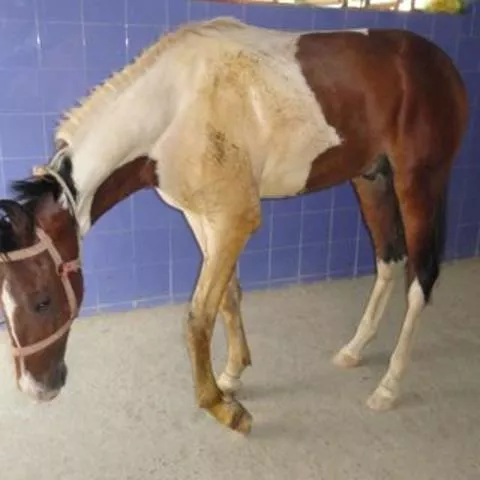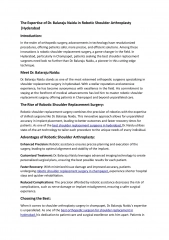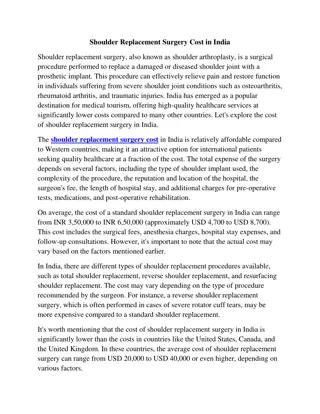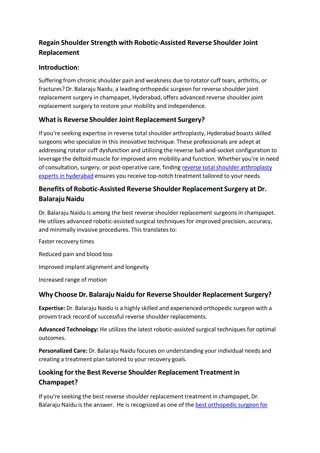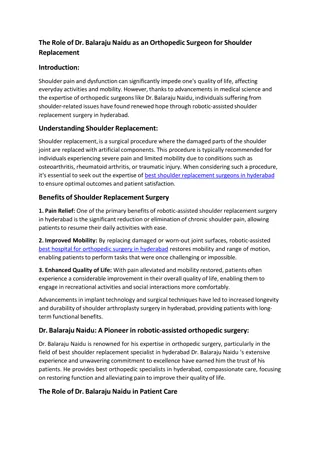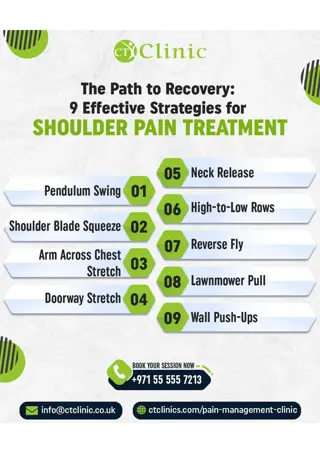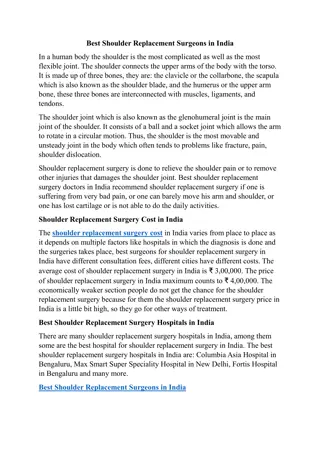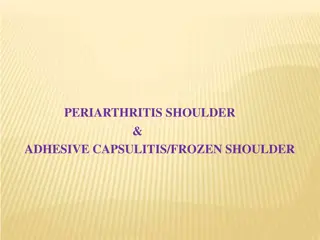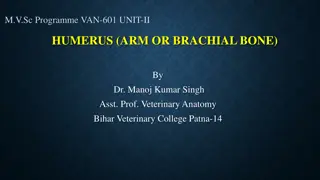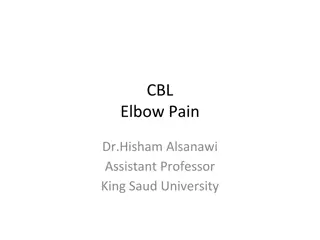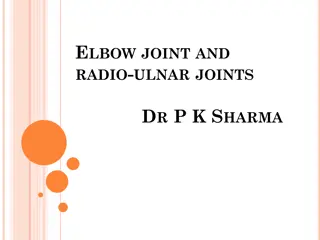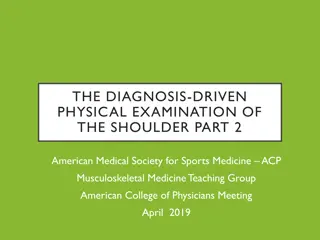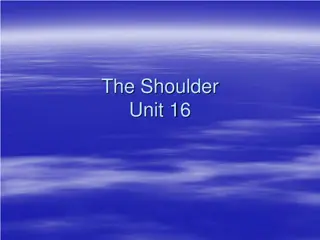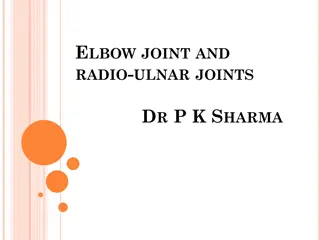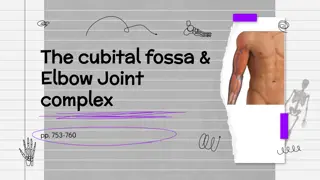Common Elbow and Shoulder Joint Conditions in Veterinary Medicine
Learn about radial paralysis, bicipital bursitis, capped elbow, and omarthritis in veterinary medicine. Understand the etiology, symptoms, and treatment options for these conditions, including corticosteroid injections and surgical debridement. Recognize the signs of omarthritis and how it affects joint movement in animals.
Download Presentation

Please find below an Image/Link to download the presentation.
The content on the website is provided AS IS for your information and personal use only. It may not be sold, licensed, or shared on other websites without obtaining consent from the author.If you encounter any issues during the download, it is possible that the publisher has removed the file from their server.
You are allowed to download the files provided on this website for personal or commercial use, subject to the condition that they are used lawfully. All files are the property of their respective owners.
The content on the website is provided AS IS for your information and personal use only. It may not be sold, licensed, or shared on other websites without obtaining consent from the author.
E N D
Presentation Transcript
Lecture 3 Radial paralysis Bicipital bursitis(intertubercular bursitis) Capped elbow(Shoe boil/olecranon bursitis) Capped elbow(Shoe boil/olecranon bursitis) Omarthritis Splints Shore shin
Radial paralysis Etiology: compression of the nerve while casting on hard ground, overstretching of the nerve, fracture of the ribs. Symptoms: complete paralysis below elbow are in flexed state(dropped elbow), limb longer and toe rest on ground, toe is dragged. Extensor of digits: use the limb normally on level ground but on uneven ground it stumbles and foot is dragged on uneven ground. Triceps muscles: inability to bear weight on the limb(not able to extend the limb), knee is semiflexed but planter surface of foot touches the ground almost normally.
Bicipital bursitis(intertubercular bursitis) Is a tendon sheath surrounds the tendon of biceps brachii in the region of inter-tubercular groove Symptoms: pain on pressure over bursa or retraction of limb,septic bursitis may occur, mineralisation within intertubercular bursa may occur as a sequele to a fracture of supra glenoid tubercle. Treatment: intra-lesional corticosteroid or sodium hyaluronate(20 mg),lavage/surgical debridement, systematic and local antibiotics,NSAIDS.
Capped elbow(Shoe boil/olecranon bursitis) Subcutaneous bursitis at the point of elbow, may occasionlly becomes abscess,common in horses and dogs(great danes), rare in cattle. Etiology: repeated trauma(contact with rough, hard ground,bad conformation of limb,e.g prominent elbows,hind foot striking against elbow),complication of infectious disease (influenza and strangles) Symptoms: acute-swelling and pain chronic-fluctuating fibrous mass due to thickening of walls of bursa and surrounding tissue Prognosis: favourable
Treatment of capped elbow Soft bedding Warm foamentations If cystic in nature-inject irritant to destruction and obliteration of synovial sac. Cauterization and insertion of seton Suppuration- treated as abscess Fibrous thickening- extirpation of bursa Asceptic aspiration and corticosteroid injection Ultrasonic or radiation therapy
Omarthritis: arthritis of shoulder joint Etiology: any type of trauma Signs: 1. Marked lifting of head when affected limb is advanced (due to minimum flexion of shoulder joint) 2. Imperfect flexion of limb (slight elevation of foot above ground) 3. Shortened anterior phase of stride, stumbling 4. Fixation of scapulo-humeral joint 5. Indifference to the hardness of the ground, circumduction of the limb. Diagnosis: by blocking median, musculocutaneous, and ulner nerves, radiography (to see growth of osteophytes) Treatment: no treatment, corticosteroids (temporary relief)
Capped knee: hygroma of carpus Definition:synovial swelling over the anterior surface of the carpal joint (acquired bursitis). Fairly common in stall fed dairy cattle and occasionally in horses. Etiology: trauma, sometimes brucella infectioncauses capped knee. Signs: pain, increased digital pulse, elevated pulse rate and temperature,anxious look, animals lift leg off ground and keep flexed for longer durations, swelling, viscid straw coloured fluid on exploration Treatment: injection of corticosteroid+antibiotics + counter pressure (repeated weekly maximum of 3-4 occasions) Chronic and fibrous form: bursectomy
Carpitis(popped knee) Acute or chronic inflammation of the carpal joint involving joint capsule,associated ligaments and bones. Fracture of carpal bones: Theradial and third carpal bones are most commonly fractured. Etiology: Trauma and overstretching of the limb Treatment: Surgical removal of the fragments or fixation of the fragments
Splints Exostosis of small metacarpal and metatarsals due to osteoperiosteitis (inner aspect of fore limb and outer aspect of hind limb) Common in fore limb and young horses below the age of 5 yrs. Types of splints: 1. Simple splints 2. Chain splints 3. Knee splints 4. Rod splints 5. Jack splints 6. Spongy splints Etiology: bad conformation, work at very young age, defective shoeing (predisposing factor), excessive concussion, sprain of suspensory ligament (exciting cause).
Symptoms of splints Imperfect flexion of the knee Marked lameness while trotting and on hard ground Lameness exaggerated while going downhill Slight abduction of limb Lameness not improving with exercise and the gait may be pottery Treatment: acute case-periosteotomy advised median and ulnar neurectomy
Sore shin (Buck-shin) Osteoperiosteitis of the ant. Aspect of large metacarpal or metatarsal bones (young horses below three yrs) Etiology: trauma. Concussion Symptoms: painful swelling, collection of exudates and mineralization of exudates causes exostosis (no lameness) Treatment: rest cold treatment, periosteotomy Sesamoiditis: inflammation of proximal sesamoids(fore limb) Symptoms: swelling and lameness, exostosis on inner aspects of sesamoids
Wind puffs Distension of great sesamoidean sheath Often associated with straight fetlocks and young horses under heavy training may develop Articular wind galls manifest as distension of the metacarpophalangeal or metatarsophalangeal joint. Symptoms: no lameness, heat or pain should be present, swelling in long standing cases (may hardens as a result of fibrosis) Treatment: use of pressure wraps and use of osmotic agents
Tendinitis (fast working animals) Sprain of flexor tendons (sprained tendon i.e sprain of superficial or deep flexor tendons their check ligaments or suspensory ligament) Site of sprain: upper or middle portion of the metacarpal region (superficial flexor tendon) Characteristic swelling of posterior aspect of the metacarpal or metatarsal region due to tendinitis and peritendinitis (bowed tendon) -Middle portion of metacarpal region or posterior aspect of pastern region (deep flexoor tendon)
Etiology of tendinitis Defective conformation, fast work, slippery ground, muscular fatigue Symptoms: pain, swelling lameness. At rest the limb is kept with fetlock and phalangeal joint slightly flexed (to relax the tendon) Treatment: corrective shoeing, acute and chronic cases (as usual) Through pin: distension of tarsal sheath due to chronic synovitis



